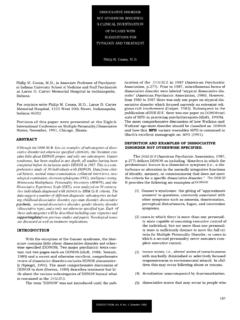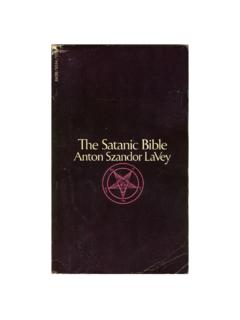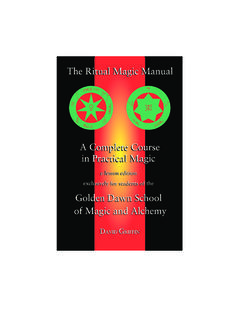Transcription of MULTIPLE DISORDER AND SATANIC RITUAL OF CREDIBILITY
1 MULTIPLEPERSONALITYDISORDER ANDSATANIC RITUALABUSE: THE ISSUEOF CREDIBILITYS usan C. Van Benschoten, , , C. Van Benschoten, , MA., is a graduatestudent. in Clinical Psychology' at Georgia State University inAtlanta. (' reprints write Susan C. Van Benschoten, , ,MA., Georgia State University, Department of Psychology,University Plaza, Atlanta, GA RITUAL abuse has gained widespread public andprofessional attention in. the past 10 years. During therapy, manyadult AMPI) ( MULTIPLE personality DISORDER ) patients describe memo-ries of .such abuse beginning in , there arepre-school children reporting cnrrent incidents of sexual and physicalabuse involving salanism in day care settings.
2 Professionals specifi-cally addressing the day care cases have attempted to delineatefeatures which distinguish RITUAL abuse from traditionalconceptualizations of rhild aim se. The of RITUAL abusewhich they have identified are presented, as well as similarities anddifferences between the child and adult 111P1) patients' questions regarding the validity and accuroc'of111Y1)patients' sratanir abuse memories are explored. The substantiatedoecumenic of RITUAL abuse in rontemporary, non- SATANIC , dangerouscults is discussed as a framework for considering the authenticity ofIbIPI) patients' SATANIC abuse accounts.
3 It is proposed thatanattitude of critical judgement concerning reports of SATANIC ritualabuse is necessary, to avoid either denying the issue or over-general-izing the nature and extent of the of SATANIC RITUAL abuse began emerging publiclyin the early 1980s. Accounts continue to come from thetelevision and news media, law enforcement sources, psycho-therapists, clergy simultaneously involved in mental healthprofessions, and both child and adult survivors. While pro-fessional literature on the topic of SATANIC RITUAL abuse isnearly non-existent, concern about the issue is becomingincreasingly widespread among many professional groupsand the example, organized lay groups are providing con-cerned citizens with educational material and linking survi-vors with professional resources.
4 Adult survivors have begunnetworking and forming support groups. Published accountsalleging and describing SATANIC RITUAL abuse are beginning toemerge ( , An tonelli, 1988; Marron, 1989; Smith & Pander,1980; Spencer, 1989). Law enforcement seminars, empha-sizing the recognition and proper investigation of ritualisticand occult-related crimes, are occurring nation-wide. Thetopic of SATANIC RITUAL abuse is being addressed at conferencessponsored by numerous psychiatric and psychological or-ganizations, including the International Society for- the Studyof MULTIPLE Personality and Dissociation, the National Coa-lition Against Sexual Assault, the National Conference onthe Sexual Victimization of Children, the U.
5 C. BerkeleyRape Prevention Education Program, and several regionalgroups in the United States studying and treating MPD. In1989, major papers and workshops on SATANIC RITUAL abusewere presented at conferences in California, Colorado,Georgia, Illinois, North Carolina, Ohio, and abuse may or may not have SATANIC , many of the allegations of RITUAL abuse which havesurfaced over the present decade specifically implicate alle-giance to or worship of Satan as the basis for accomplishingor justifying the ceremonial activities performed. Althoughthe prevalence of SATANIC RITUAL abuse is not known, itsinvolvement in a variety of social contexts and diverse beliefsystems has been reported.
6 Highly secretive and rigidlystructured cults have been implicated, as well as groupsexploiting day care centers, groups disguised as traditionalreligious structures, families (including ), small self-styled adolescent groups, childpornography and drug rings, and individuals acting eitherindependently or within loosely knit groups (Brown, 1986:Gallant, 1986, 1988; Gould, 1986, 1987; Kahaner, 1988;Young, 1989).Attitudes, values, purpose, degree of dangerousness,number of members, nature of individuals'involvement,type of organizational structure, and degree of secrecy andisolation from society are reported to vary among differentsatanic contexts.
7 Additionally, those who are investigating,writing, and speaking about SATANIC RITUAL abuse differ intheir assessments of the nature and magnitude of dangeroussatanic activity, and the degree of organization and network-ing between SATANIC SATANIC RITUAL abuse is described within a theis-tic or atheistic belief system, and whether spiritually, philo-sophically, politically, socially, or personally motivated, theatrocities being reported are profoundly similar among twosurvivor groups currently receiving attention from law en-forcement and mental health professionals: adult survivorsdescribing experiences of SATANIC RITUAL abuse beginning inchildhood (Braun, 1989h: Braun & Gray, 1986, 1987; Braun& Sachs, I988; Kahaner, 1988; Olson, Mayton, & Kowal-Ellis,1987; Young, 1989), and pre-school children reporting22 DISSOCIATION,1' No, 1:March 1990 VANBENSCHOTEN current incidents in day care settings (Believe the Children,1989; Gould, 1986; Hudson, 1988; Kagy, 1986; Kahaner,1988).
8 The comparability of both the child and adult ac-counts is said to transcend geographical and relationshipboundaries, with descriptions emerging from both survivorgroups revealing common themes, behaviors, symbols, andparaphernalia. Assuredly, the possibility of cross-contamina-tion of accounts exists when, for example, a group of sus-pected or potential victims seems to he involved in a singleday care case, or when adult contemporaries are aware of thedetails of others' reports. However, one can not discount thesimilarity of accounts given spontaneously and independ-ently by individuals who are unrelated personally, geo-graphically, or through shared first introduced the term, "ritualized abuse,"in1980 to describe the experiences of an adult survivor disclos-ing SATANIC abuse memories.
9 He defined the phenomenon as"repeated physical, emotional, mental, and spiritual assaultscombined with a systematic use of symbols, ceremonies, andmachinations designed and orchestrated to attain malevo-lent effects" (Pazder cited in Kahaner, 1988, p. 201) . Subse-quent definitions have emerged primarily from profession-als addressing RITUAL abuse in child care settings. Finkelhor,Williams, Burns, and Kalinowski (1988) elaborate Pazder'sview, defining RITUAL abuse as "abuse that occurs in a contextlinked to some symbols or group activity that have a or supernatural connotation, and where the invo-cation of these symbols or activities are repeated over timeand used to frighten and intimidate the children" (p.)
10 52).Kelley (1988) refers to RITUAL abuse as "repetitive andsystematic sexual, physical, and psychological abuse of chil-dren by adults as part of cult or SATANIC worship"(p. 288).Conversely, Gallant (1986, 1988), a San Francisco policeinvestigator, contends that satanism is not necessarily afactor in child RITUAL abuse cases, even when reports includedescriptions of symbols, paraphernalia, or activities whichappear SATANIC . Emphasizing the highly specific nature ofsatanic RITUAL abuse, Gallant (cited in Kahaner, 1988) stronglycautions professionals against automatically or prematurelylinking cases of child RITUAL abuse with organized Gallant's view (1986), three categories of individualsmay be involved in crimes with SATANIC overtones: the tradi-tional satanist, who is part of an organized religious groupworshipping Satan as a legitimate spiritual force; dabblers,comprised of individuals using the guise of religion, in thiscase satanism, to justify criminal activities.










